|
Packaging Tips |
| |
| External
Packaging |
Bags
Place items in protective bags, padded bags or
bubble bags. These bags are good for shock
absorption and some are also waterproof and
anti-static, hence useful for sensitive items like
diskettes, tapes and electronic parts. |
Flyers
To ensure the ease of sorting for small parcels or
documents, City-Link provides flyers upon request
for customers to enclose their shipments in. These
flyers have a security seal to prevent any tempering
during the forwarding process. |
The
Flyers come in 3 sizes:
| Name |
cm |
Inches |
| A2 |
42.0 x 59.4 |
16.5 x 23.4 |
| A3 |
29.7 x 42.0 |
11.7 x 16.5 |
| A4 |
21.0 x 29.7 |
8.3 x 11.7 |
|
Some
considerations when using the flyers:
- Compact discs or similar items should be placed in
a proper casing before inserting into the flyers
for additional protection.
- For
documents, it is advised that a cardboard should
be placed together so that bending or folding will
not occur easily during the forwarding process.
- Sharp edges of the shipment item should also be
taken care of so that they will not tear the
flyers easily.
- Try
not to insert shipments of excessive weight or
size into one flyer, as the flyers may tear as
well. Usage of boxes can be considered.
|
Corrugated boxes
Using corrugated boxes is a common way of packaging
most shipments, as they provide adequate protection
to the shipments from any rough handling during the
forwarding process.
When using boxes for packaging, proper internal
cushioning is advised to prevent the items from
moving and knocking against the boxes. Taping and
sealing of the boxes should be done to prevent the
boxes from being opened easily. |
|
| |
| Internal
Packaging |
Adequate spacing should be kept between the
packaging and the shipment item for proper
cushioning or fillers. Filler materials can be any
form of light and loose materials. Some of more
economical methods are using shredded or crumpled
newspapers. Proper cushioning provided by these
fillers helps to keep the shipments in the centre of
the packaging, and also provide necessary shock
absorption. However, for heavy items, proper
strapping or dividers should be made as these
fillers may not be strong enough to keep the items
intact.
When there are multiple items packed into one box,
dividers should be used to that items are arranged
in proper partitions or stacks. Corrugated sheets or
layers of cupboards can be used for such purposes. |
|
|
| Sealing
Packages |
Taping
Proper sealing and taping is necessary so that the
items in the packaging do not fall out easily. The
better the taping is done, the less chances of
packaging will break or open during transit. For
heavy shipments, heavy-duty taping materials should
be used.
Customers should not use paper-backed tape,
household cellophane tape, masking tape, paper
activated tape, strings or ropes for sealing as they
may be cut or torn easily. String and ropes may also
damage the boxes and in turn expose the items
inside.
Good tapes should be pressure sensitive and
approximately 2 inches wide and be applied on all
seams and flaps of the packaging. Refer to the
diagrams below:
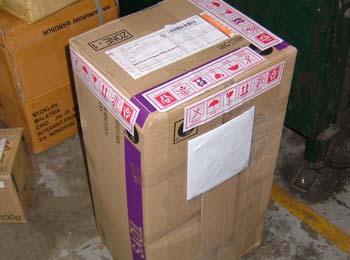 |
Strapping
Strapping is important to strengthen the package of
heavy shipments. The same tapes for sealing can also
be used to strap the packages. Other materials such
as polypropylene, polyester or metal can also be
used depending on the nature of the shipped items
and packaging materials. Metal straps should only be
applied if wooden boxes are used, as they can cut
through any paper materials. Strings and ropes
should also be avoided for strapping as they can be
cut easily.
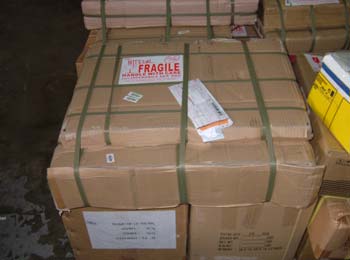 |
Wrapping paper / Film
Wrapping should be done on packages or items to
prevent any damage by dust or water. Examples of
such items are rolled-up textiles or drawings. |
|
| |
| Addressing / Labeling |
Please make sure that all necessary shipper and
consignee information are properly filled in on the
consignment notes or shipping labels.
For any recycled packaging used for shipping,
customers should ensure proper strapping and taping
are done properly. Any old shipping labels or
consignment notes should be removed or crossed
prominently using proper markers.
The consignment notes should be placed on the top,
or the side of the package with the biggest surface
area on the outside of the box. This is to ensure
the ease of identifying the details on the shipment.
Please do not place the consignment notes around the
corner or over the seams of the package, as they can
be scratched or torn easily during transit. |
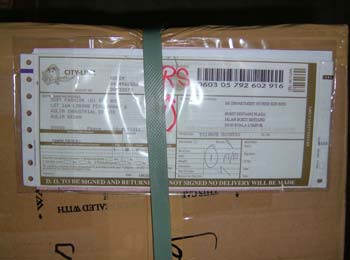 |
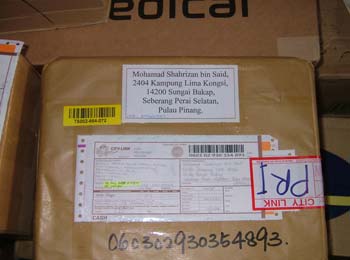 |
| Make
sure that the consignment notes are properly stuck
to the packages, apply pressure to all adhesive
tapes used on the sticking of the consignment notes.
However, do not places the tapes over the
shipper/consignee information, as the information
may not be read by the barcode readers properly.
Customers should also avoid wrinkling, scratching or
mark the consignment notes. |
|
|
| Packaging
Do's and Don'ts |
| Do's |
- Choose the right size and material for the package
to hold the content. Remember to leave adequate
space for proper cushioning.
- Balance the weight and the strength of the boxes,
and also the nature of your shipments for proper
packaging. Use corrugated boxes for most common
items.
- Cushioning materials is a must. Use fillers,
sponges, shredded or crumpled newsapepers.
- Use
water-proof and pressure sensitive tapes for
sealing your boxes.
- Strap the heavy boxes to strengthen the package.
- Stuff cushioning materials in hollow and fragile
items. Place them in the center of the box and
packed the rest of the box with fillers. Don’t let
them hit the sides.
- Tightly seal any liquid containers, make sure they
do not leak. Wrap them in plastic if possible.
- Wrap any sharp objects with layers of papers or
cardboards and secure with adhesive tapes so that
they do not cut the packaging and damage other
shipments.
- Place documents on cardboards before putting them
into the flyers. This will ensure them from being
bent or folded easily.
- Make sure cushioning it done between multiple
items when they are stacked together in one
shipment.
- Indicate which side of the box should be on top.
Place the consignment notes on the top of the
boxes to increases the chances of being placed at
a proper orientation.
- Packaging for expensive gifts should be packed
properly to prevent any unnecessary attention.
|
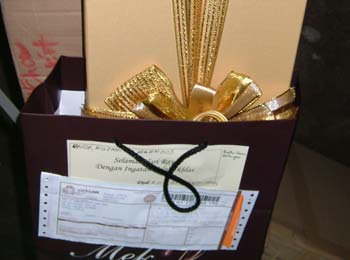 |
- Avoid using round cylinders, try triangular tubes
ones instead so that they will not move about
easily during transit.
|
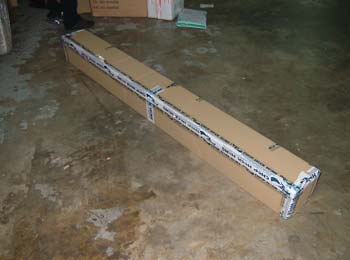 |
- Complete shipper and consignee information
clearly. Make sure proper contact details are
provided.
- Complete the address clearly and completely, using
uppercase letters when handwriting labels to
improve readability for DHL personnel.
- If
a recycled box is used, make sure all old labels
are removed or cross out. Make sure extra
strapping is done to strengthen the packaging of
the shipment.
|
| Don'ts |
- Don’t use non water-proof bags.
- Don’t ship liquids or spillable items in envelopes
or City-Link flyers.
- Don’t ship fragile or breakable items in envelopes
or City-Link flyers without any proper padded
packaging done.
- Don’t use paper-back or house-hold cellophane
tapes which are not strong seal the shipments
properly.
- Don’t use strings or ropes to seal any corrugated
boxes, they can damage the boxes easily.
- Don’t consider "Fragile" and "Handle with care"
labels as a substitute for careful packaging. They
are only appropriate for information purposes.
- Don’t cover the shipper and consignee information
on the labels
- Don’t tape anything over the consignment notes.
|
|
| Ways of
packaging specific items |
|
